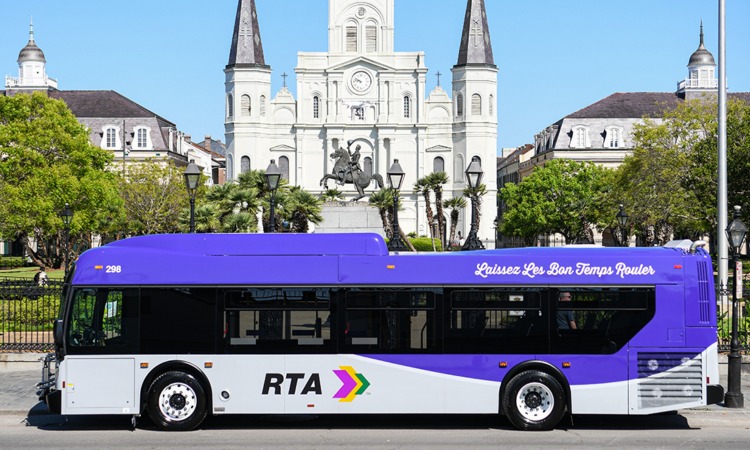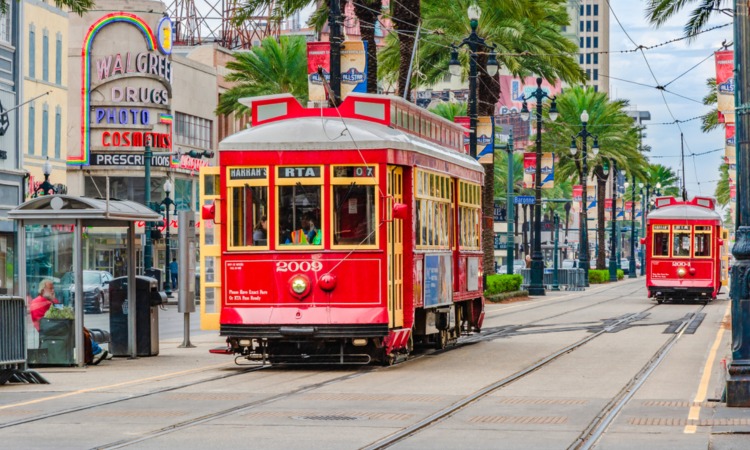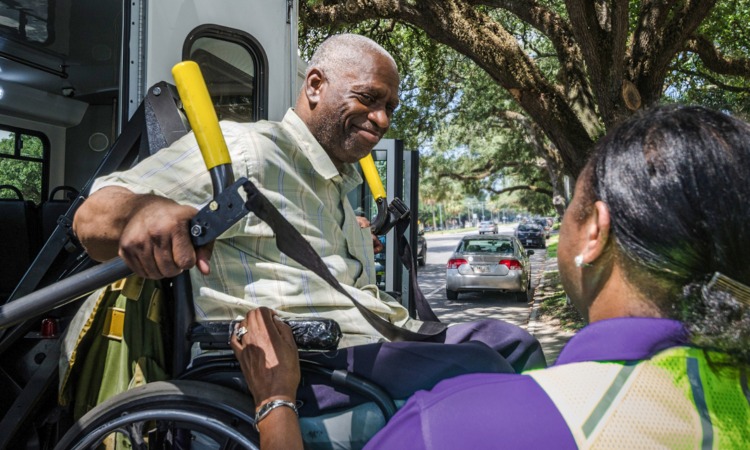Getting passengers back on-board: New Orleans RTA’s road to recovery
- Like
- Digg
- Del
- Tumblr
- VKontakte
- Buffer
- Love This
- Odnoklassniki
- Meneame
- Blogger
- Amazon
- Yahoo Mail
- Gmail
- AOL
- Newsvine
- HackerNews
- Evernote
- MySpace
- Mail.ru
- Viadeo
- Line
- Comments
- Yummly
- SMS
- Viber
- Telegram
- Subscribe
- Skype
- Facebook Messenger
- Kakao
- LiveJournal
- Yammer
- Edgar
- Fintel
- Mix
- Instapaper
- Copy Link
Posted: 21 November 2022 | Alex Z. Wiggins - New Orleans Regional Transit Authority | No comments yet
For the latest instalment of Intelligent Transport’s exclusive COVID-19 recovery series, Alex Z. Wiggins, CEO of the New Orleans Regional Transit Authority, discusses the challenges that the authority experienced throughout the COVID-19 pandemic and the measures that it adopted to help overcome them, as well as why it is so important for the transport sector to take a range of demographics – such as race, economic status and gender – into consideration, in order to truly deliver equitable transit services for communities.


Credit: New Orleans Regional Transit Authority
The New Orleans Regional Transit Authority (RTA), like the majority of transit agencies across the globe, is engaged in ongoing problem-solving efforts to reverse significant reductions in ridership and revenue brought on by the COVID-19 pandemic. With ridership losses peaking at about 90 per cent during the first few months of the pandemic, we were forced to shift our thinking with regards to passenger needs and expectations, service planning and transit equity, as well as how we manage our operating and capital budgets.
With ridership losses peaking at about 90 per cent during the first few months of the pandemic, we were forced to shift our thinking with regards to passenger needs and expectations”
The resulting strategy focuses on three distinct areas – asking passengers what they need, making transit more affordable and, most importantly, prioritising equity as a key performance indicator. New Orleans is unlike any other city in the world. We are a blended culture comprised of Indigenous, African, LatinX and European influences. We are unique in the fact that we embrace the challenge of achieving equity head-on.
RTA is the heartbeat of New Orleans. Our iconic trams are the oldest continuously operating tram system in the world. And no matter what traumas we endure – whether hurricanes or COVID-19 – the city’s residents always feel relieved when the tram service resumes. So, we made the decision early on that we were going to maintain mobility for the riders who needed us the most. Despite reducing service across all modes by as much as 50 per cent, we were able to maintain mobility for the essential workers who saved lives and kept commerce rolling throughout the pandemic.


What priorities are important to our passengers?
Our customers clearly stated their priorities: reduced wait times, better access to employment, educational and shopping centres, as well as greater RTA investments in basic amenities like bus shelters”
At the onset of the pandemic, only months earlier, we initiated efforts to re-design our entire transit network. In partnership with the New Orleans Regional Planning Commission, our primary goals were focused heavily on increasing ridership and improving mobility while using existing resources. The New Orleans transit market is unique. We operate trams and ferry services used by residents and tourists alike, but it is our bus system that moves most passengers – about 75 per cent of our 20 million pre-COVID-19 annual passenger trips. COVID-19 changed everything. In the face of a steep decline in ridership, it became immediately clear that emphasising ridership growth was unrealistic. Instead, we decided to go back to the drawing board and ask passengers what they wanted.
Relying on customer interactions and feedback facilitated by virtual meetings, social media and online surveys, we changed course. Our customers clearly stated their priorities: reduced wait times, better access to employment, educational and shopping centres, as well as greater RTA investments in basic amenities like bus shelters. We listened and introduced a re-designed transit network in September 2022. The new system reduces wait times across most of the network and provides better access to the destinations that are important to our passengers. We are also adding new bus shelters in 2022 and adding the engineering and design costs to build a new transit centre in our upcoming 2023 budget.

Making transit more affordable
At a base fare of $1.25 per one-way trip, RTA has one of the lowest transit fares of any major city in the U.S. Under even the best of circumstances, it’s quite difficult to operate and maintain a transit system with 900 employees and operate bus, tram, ferry and paratransit modes when passenger revenue covers less than 20 per cent of operating costs. Compounded by the reduction of sales tax income, our short-term economic outlook was dire. Without the early intervention of the federal government, there is no doubt in my mind that we would not be operating transit service today.
If we, as a transit operator, were tightening our belts due to reduced income, then so are our passengers. So, we decided to lower our fares to incentivise ridership”
Unlike the disruption brought on by the COVID-19 pandemic, the hybrid workplace is here to stay. Despite the all too frequent emergence of yet another variant, I believe the medical community will at best make COVID-19 a distant memory, or at the very least mitigate its harmful effects in the same way that we approach the flu. Given that employees are demanding greater flexibility in their schedules and employers are maintaining and/or improving productivity, the transit industry must adapt to this change and develop new incentives to ride.
In response to the significant reduction in commuters traveling back and forth between home and the office, we decided to reduce our transit fares to attract passengers. Our reasoning was straight forward – if we, as a transit operator, were tightening our belts due to reduced income, then so are our passengers. So, we decided to lower our fares to incentivise ridership. We introduced the following new products in January 2022:
- $45 Adult monthly unlimited pass
- $18 Youth monthly unlimited pass
- $14 Senior unlimited monthly pass
- $1 Youth unlimited day pass
- $0.80 Senior unlimited day pass.
The results, as of September 2022, are quite promising. Pass sales have increased by 60 per cent compared to pre-COVID-19 sales and ridership is approaching 70 per cent of pre-COVID-19 levels. While our total passenger revenue is still below 2019 performance, we are optimistic about the current growth trend.


Credit: New Orleans Regional Transit Authority
Equity as a key performance indicator
As transit professionals, we measure our success by achieving year over year growth in ridership and revenue, improving on-time performance, as well as maximising fare recovery ratios. All-important, indeed! But COVID-19 has shifted the paradigm. While it’s true that we must always prioritise operating safe and reliable transit systems, we must re-define what it means to be successful in this industry.
Over the course of my two decades in this industry, I have worked for systems of all sizes. Some handling more than 300 million annual passenger trips, others handling 12 million annually or less. But, at every agency, we were focused on moving the greatest number of passengers as quickly and efficiently as possible. That is what makes mass transit viable.
But COVID-19 taught us many lessons and shifted our thinking. As an industry, we were forced to reduce or, in some cases, cease operations altogether for a period. When grappling with this issue in New Orleans, we decided that it was more important to focus on who needed transit service during the pandemic than focusing primarily on how many passenger trips we achieved. For many communities, transit service is a vital lifeline providing access to educational, employment, hospital and shopping facilities. In many cases, transit is the only option.
Mobility is a right that should not be limited by demographics like race, economic status or gender, among others”
At the RTA, we were intentional about how we approached the immediate challenges posed by the pandemic, as well as our recent system re-design. We incorporate the concepts of race and social justice into everything that we do at the authority. While the concept plays a role in who we hire or do business with, the customer facing role is equally and critically important. Mobility is a right that should not be limited by demographics like race, economic status or gender, among others. Given that equity looks different in every community, there is no one panacea. In our case, we take the following approach:
- Seek to eliminate racial inequality and advance equity
- Engage the community in decision making processes
- Identify who will benefit or be negatively impacted by our decisions
- Identify potential unintended consequences
- Commit to mitigating adverse impacts.
Again, equity looks different in every community. But, defining inequity is not a difficult exercise. No matter who you are, where you live, your gender or race, I am confident that, at some point in your life, you have been treated with disrespect – just because of who you are. Do you remember how that incident made you feel? As an industry, we must commit to not doing any harm.
The coming years will continue to challenge our industry. We will emerge on the other side of COVID-19 with new models to accommodate the hybrid workforce, develop new incentives to generate ridership, as well as refining our most important task – delivering safe and reliable transit service for all.


Alex holds a Master of Science Degree in Management from the University of Maryland University College, and a Bachelor of Arts in Communication from Arizona State University.
If you would like to take part in our ‘Getting passengers back on-board: Transport’s road to recovery’ series, or would like to nominate a colleague to take part, please email: Halimah Haque, Editorial Assistant, Intelligent Transport.
Related topics
Accessibility, COVID-19, Fleet Management & Maintenance, Getting Passengers Back On-Board: Transport's Road to Recovery Series, Mobility Services, Passenger Experience, Public Transport, Ticketing & Payments
Related modes
Bus & Coach, Ferry, Trams
Related cities
New Orleans
Related countries
United States
Related organisations
New Orleans Regional Transit Authority (RTA)
Related people
Alex Z. Wiggins







